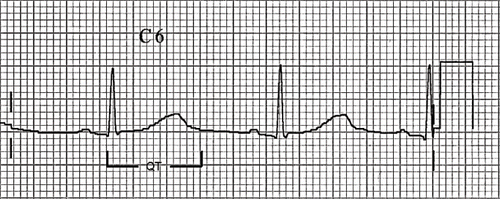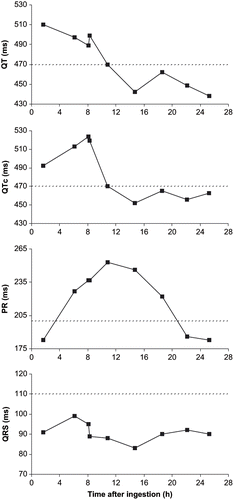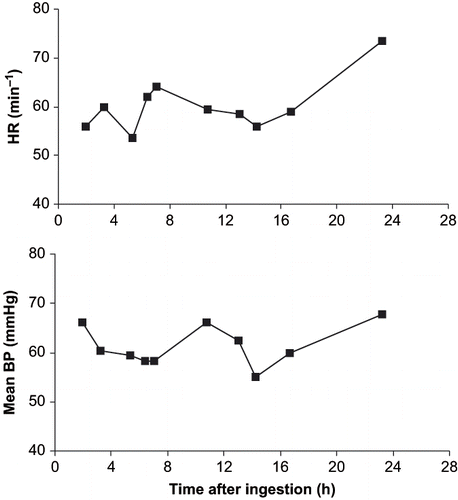Abstract
Trazodone possesses minimal anticholinergic properties and, therefore, is generally regarded as having less cardiotoxic potential than other antidepressants. This report describes a young woman who developed significant QT prolongation and delayed atrioventricular nodal conduction after acute trazodone overdose. The case adds to the existing literature because it has a number of strengths, namely that confounding drugs and alcohol were lacking, trazodone exposure was confirmed by drug assay, and early presentation to hospital gave a valuable opportunity to study the time-course of the cardiac effects. This case reminds us to consider the possibility of cardiotoxic effects after trazodone overdose, even in young patients with no established cardiovascular disease.
Introduction
Trazodone is a triazolopyridine derivative that is a widely used in the treatment of depression and anxiety. Its pharmacological profile is distinct from other major antidepressant groups, characterized by alpha-adrenoceptor blockade and relative lack of anticholinergic effects (Citation1). Trazodone is generally regarded as having less cardiotoxic potential than other antidepressants (Citation2). This report describes a young woman who presented to our Emergency Department and developed significant QT prolongation and delayed atrioventricular nodal conduction after acute trazodone overdose. Trazodone was implicated as cause of the cardiac effects because of the consistent temporal relationship, lack of co-ingested drugs or alcohol, and absence of underlying cardiac disease. This case reminds us to consider the possibility of cardiac toxicity in patients who present to hospital after recent trazodone ingestion.
Case report
A 20-year-old woman presented to the Emergency Department after deliberate ingestion of trazodone 1.5 g (Molipaxin®) 1 hour earlier. She denied taking other medications or alcohol. Past history included personality disorder and previous drug overdose. Initial symptoms were sedation and nausea. On examination, Glasgow Coma Scale was 12, swallow and cough reflexes were intact, pulse rate 57 min−1, blood pressure mmHg, and respiratory rate 11 min−1. Management consisted of intravenous colloids and nursing in head-downward tilt posture to maintain systemic blood pressure, frequent assessment of conscious level, regular haemodynamic observations, and electrocardiograph monitoring. The admission electrocardiograph showed significant QT prolongation (). Serum electrolytes, calcium and magnesium concentrations were normal, plasma alcohol < 2 mg/dL, neither paracetamol nor salicylates were detected in serum, and a urine toxicology screening was negative.
Fig. 1. Electrocardiogram 6 hours after trazodone ingestion showing QT prolongation; calibration amplitude 1 cm = 1 mV, strip recording rate 25 mm.sec−1. Heart rate 64 min−1, PR interval 227 ms, QRS 99 ms, QT 513 ms, corrected QT (Bazett's formula) 497 ms.

After admission, the QT interval gradually corrected, and had fallen to within normal values within 12 hours after ingestion. However, the PR interval progressively increased in the first 12 hour post-ingestion, and did not fully recover until 24 hours (). aemodynamic observations were stable throughout (). t 24 hours post-ingestion, conscious level had recovered, the electrocardiographic abnormalities had fully resolved, and the patient was discharged home. Serum trazodone concentrations were 1.9 mg/L and 1.2 mg/L at 5 and 16 hours after ingestion, respectively.
Discussion
In this previously healthy young woman, with no pre-existing cardiac disease, acute trazodone ingestion caused prolongation of the QT interval and atrioventricular conduction. The case is distinct from other reports in the literature because confounding drugs and alcohol were lacking, trazodone exposure was confirmed by drug assay, and the early presentation to hospital gave a valuable opportunity to study the time-course of the cardiac effects from soon after ingestion until resolution.
Recognized features of trazodone toxicity include drowsiness, ataxia, nausea and vomiting, dry mouth and, in severe cases, coma and death (Citation3). Cardiovascular effects of trazodone ingestion are generally minor, and include mild hypotension. A small number of fatalities have been reported, and these have involved patients who ingested massive quantities of trazodone or co-ingested other drugs, particularly selective serotonin reuptake inhibitors (Citation4,Citation5). Both QT prolongation and torsades de pointes are recognized complications of trazodone overdose (Citation6,Citation7). Therapeutic use may also be associated with development of arrhythmia in elderly patients with established cardiac disease (Citation8,Citation9). The clinical significance of QT prolongation derives from its close association arrhythmia risk, especially torsades de pointes. This case indicates that acute ingestion of trazodone may be sufficient by itself to cause QT prolongation and, therefore, may increase the risk of life-threatening arrhythmia.
Prolongation of the PR interval signifies delayed atrioventricular conduction. This is a documented effect of tricyclic antidepressants, particularly in patients with pre-existing cardiac abnormalities (Citation10). However, this manifestation of trazodone-induced cardiotoxicity has received comparatively little attention. One evaluation suggested that trazodone does not exert effects on the PR interval, whereas another report found acute administration capable of impairing atrioventricular conduction and causing complete heart block (Citation11,Citation12). Inconsistencies might, at least in part, be due to different cardiac effects of acute and chronic trazodone therapy (Citation13).
Drug assays confirmed trazodone exposure, and exponential two-point kinetic analysis suggests a peak trazodone concentration of 2.3 mg/L in our patient (y = 2.308e−0.039x). Toxic effects correlate poorly with serum concentrations after trazodone overdose (Citation3,Citation4). Serum concentrations of around 1.2 mg/L are sufficiently high to prolong the QT interval by 25 ms in healthy young people (Citation11). Therapeutic use is associated with a 10-fold inter-individual range of serum concentrations, for example 0.2–2.0 mg/L (Citation14).
A limitation of this report is that we are not able to comment on potential mechanisms by which trazodone is capable of prolonging the QT interval and delaying atrioventricular conduction. However, it appears highly specific pathways are involved, due to the lack of acute effects on QRS duration. The temporal pattern of trazodone effects on QT and PR intervals were different, suggesting that discrete mechanisms may be responsible for each. Previous studies show trazodone capable of prolonging the QT interval, in vitro, by inhibiting inward rectifier potassium channel activity (Citation15). Further work is required to elucidate the exact pathways involved.
Acute trazodone overdose may cause QT prolongation and impaired atrioventricular conduction, even in the absence of underlying cardiac disease. Patients who present to hospital after trazodone overdose should have an electrocardiograph performed, and be considered for cardiac monitoring for up to 6 hours after ingestion to allow detection of those at highest risk of arrhythmia.
References
- Brogden RN, Heel RC, Speight TM, Avery GS. Trazodone: A review of its pharmacological properties and therapeutic use in depression and anxiety. Drugs 1981; 21: 401–429
- Jackson WK, Roose SP, Glassman AH. Cardiovascular toxicity of antidepressant medications. Psychopathology 1987; 20(Suppl 1)64–74
- Henry JA, Ali CJ, Caldwell R, Flanagan RJ. Acute trazodone poisoning: Clinical signs and plasma concentrations. Psychopathology 1984; 17(Suppl 2)77–81
- Goeringer KE, Raymon L, Logan BK. Postmortem forensic toxicology of trazodone. J Forensic Sci 2000; 45: 850–856
- de Meester A, Carbutti G, Gabriel L, Jacques JM. Fatal overdose with trazodone: Case report and literature review. Acta Clin Belg 2001; 56: 258–261
- Levenson JL. Prolonged QT interval after trazodone overdose. Am J Psychiatry 1999; 156: 969–970
- Wittebole X, Jacquet L, Wallemacq P, Hantson P. Trazodone poisoning with torsades de pointe and prolonged need for inotropic support. Clin Toxicol 2000; 38: 248
- Vitullo RN, Wharton JM, Allen NB, Pritchett EL. Trazodone-related exercise-induced nonsustained ventricular tachycardia. Chest 1990; 98: 247–248
- Mazur A, Strasberg B, Kusniec J, Sclarovsky S. QT prolongation and polymorphous ventricular tachycardia associated with trazodone-amiodarone combination. Int J Cardiol 1995; 52: 27–29
- Glassman AH, Preud'homme XA. Review of the cardiovascular effects of heterocyclic antidepressants. J Clin Psychiatry 1993; 54(Suppl)16–22
- Burgess CD, Hames TK, George CF. The electrocardiographic and anticholinergic effects of trazodone and imipramine in man. Eur J Clin Pharmacol 1982; 23: 417–421
- Rausch JL, Pavlinac DM, Newman PE. Complete heart block following a single dose of trazodone. Am J Psychiatry 1984; 141: 1472–1473
- Van de Merwe TJ, Silverstone T, Ankier SI. Electrophysiological and haemodynamic changes with trazodone, amitriptyline and placebo in depressed out-patients. Curr Med Res Opin 1984; 9: 339–352
- Siek TJ. Determination of trazodone in serum by instrumental thin-layer chromatography. J Anal Toxicol 1987; 11: 225–227
- Tarantino P, Appleton N, Lansdell K. Effect of trazodone on hERG channel current and QT-interval. Eur J Pharmacol 2005; 510: 75–85


